Jarana

“There is nothing new under the sun, but there are new suns.” –Octavia Butler

20–25 minute experience, or the time it takes to walk around the neighborhood.
How does the process of making an instrument mimic the process of making a song? For musician and laudero (luthier) César Castro, the two are linked through son jarocho, the musical tradition of Veracruz, Mexico, and the jarana, its chief instrument. In a commissioned new song, “Mi Jarana,” and an accompanying interview with Jessica Ferrer, Castro celebrates the instrument’s history, its material origins in wood, and how working closely with it over time has deepened his connection to his community.
BY CÉSAR CASTRO

[Audio Description: Soft and consistent rhythm is strung on a jarana. In the background, a slight sanding and shaving sound is introduced. The sanding sounds much like the sanding of wood, indicating the process of making a jarana. Suddenly, vocals begin to accompany the music as a strong, warm voice sings in Spanish. The lyrics are sung in the same verse structure as “La Bamba.” The earlier sanding motion is quickly replaced with the knocking and hammering of wood, most noticeable during the lyrics, “Es mi jarana.” The strings of the jarana grow louder and brighter as the sanding and knocking continue in the background. The music picks up with additional harmonizing backing vocals and instrumentation, sounding as though it’s a band or quartet, the vocals floating in and out by verse and at a steady pace. The rhythm of the jarana carries into the final strings as the song closes out.]
Jessica Ferrer: Alright, well thank you so much César! I want to kick it off with this first question: what does the song writing process look like for you generally? Do you tend to start with a chord, or a melody, or then add lyrics? Does it change?
César Castro: It always starts with thinking, and sometimes overthinking, about what I want to sing about and how I’m going to put those ideas into music. Do I want it to be traditional? Do I want it mixed? Or should I branch out and try something no one has heard from me before. That’s a lot of thinking. Sometimes I have to do research if I want to touch on historical aspects. Then when it’s time to hit the recording button, it’s mostly on the chords, harmony, and rhythm, or lyrics. Sometimes I hit the lyrics first, like oh, I like this line! The line gives you a rhythm and from there I pick up. Never from a melody. The melody comes [later]. What I get ready for is also the mood. Do I want it slow, mid, or fast? How happy? From there, if it’s going to be minor, major, combined, all those details. Instrumentation comes at the end. Sometimes I get too excited and I start recording everything, and then [I’m] muting, muting, muting. The beauty of technology nowadays is, it allows you to not just imagine, but to have the real sound there and then decide later.
I heard the instrument and I was attracted to it. I said, “What is that? What is that? I want to play it.”
Jessica: In this piece that you’re sharing, “Mi Jarana,” there’s a sense of joy and appreciation, I think, not only for the instrument, but also its material origins. What do you like about working with wood, and conversely, what is challenging or hard about working with it?
César: When I started learning son jarocho, the first thing was having a jarana in my hands. I heard the instrument and I was attracted to it. I said, “What is that? What is that? I want to play it.” So the first time I hit it, it gave me a feeling through sound that I had never felt before. I know we’ve heard that so many times, but what your body experiences is something very strong. I was thirteen, so I was too young to put words on those things, I was more responding to the organic aspect of it.
Later on I went to the fandango, which is a traditional celebration with son jarocho, where people gather, spending hours playing and dancing and singing. When I got exposed to that I started to feel very convinced and confident about being part of it, because I’m from the city. I’m from Veracruz City. When I went to the countryside and experienced that, it was a lot. It was probably too much for me to the point where I thought I was confused. I had these personality issues. I mean, I was a teenager so it was normal. But between being urban or being from the countryside…
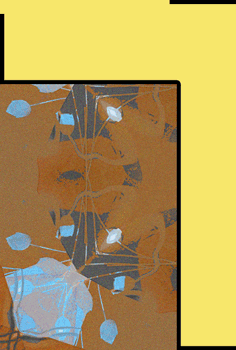
I started learning how to make instruments at the age of fifteen, two years later. That’s when I first got in contact with the wood, but from a different aspect, not just by playing or dancing on top of wood, but now by shaping the wood, carrying the big pieces onto a table, and then using different tools to create different shapes and different parts of the instrument. The pieces that fell, the smell, everything around you, the dust on your face and your hands — you are very involved with the wood, to the point where you start thinking differently about trees and about the history and the destiny of those pieces of wood. In this song that’s something that I touch on. I said something about growing from the roots, and being a mix of life or death, and then I ask, what’s wood for you? What’s wood for you? It could be a tool, it could be your house, could be a casket. The wood we’ve been using for centuries would do different things. In my case, it’s mostly to make music. By now you can tell that my relationship with wood is very deep and I respect the characteristics of wood, how it can give us so many things. If you think about it, some things are not made out of wood, but wood was probably needed somewhere in the process. It’s amazing. I love it!
You are very involved with the wood, to the point where you start thinking differently about trees and about the history and the destiny of those pieces of wood.
Jessica: Yeah it really comes through. I think even just as you’re talking, but also in all the ways you’ve alluded to it in your practice. It leads nicely into my next question because I’m very curious about the process of making a jarana from start to finish. Especially as you’re motioning about how much the wood is, the weight of the wood. How much are you working with? Just giving folks a sense of that process would be awesome.
César: Well, thick solid pieces of wood are used to draw the shape of the instrument. You can use some patterns, or you can go from scratch, or however you want. At that point you can decide how big, how wide the instrument is gonna be and start imagining how it’s gonna sound. A jarana is made probably 98 percent out of wood. You barely see pieces from other materials. First the body gets cut, the shape gets cut all around, and then you carve out where the box is going to be. That’s where I get this first sound, knocking. It’s a sound that when you’re working, you always want to hear it, because even if you measure, it’s this sound that tells you how it’s resonating. So, anyway I still have a long process to go.
After you get that sound, you start cutting off the neck, take out the piece under where the fret board is gonna be. But the fretboard, bridge, and the tuning picks are made of hardwoods. The body is a mid: I use mahogany for those who know about wood. In Veracruz I used to use Spanish cedar. For the top, we use softer pieces of wood — I can use spruce, I can use cedar, that’s either from pine or other tropical wood — and you glue it on top of that box that you had carved out. The fretboard is where you need to work a little more mathematically to get the frets in place. Those are made nowadays of metal but before, they used to use bone or even hardwood or other pieces of wood. Now, that is too much work to do. They don’t last as long as the metal so you’re gonna have to replace them every every five years or so depending on how much you play. Now the instrument has a top, has a fretboard. The tuning pegs probably are made, but you’re still holding them somewhere else in the workshop.
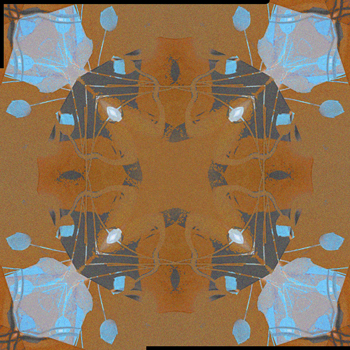
Then, a lot of sanding! Shaping the neck as thick as you want it, as rounded as you want it. There’s some parts on the head that you can give different personal aesthetics to that have nothing to do with the mechanical function or acoustics. After sanding, you varnish it. If you want it darker, then you use some varnishing that has dye. If you want it clear, give it 3 to 5 [passes], we call them hands or faces. So you go five times, sanding and varnishing, until it gets really smooth and shiny. String it, tune it, and have a lot of fun with it.
A jarana can last your whole life. They are not as disposable as technology these days. So that’s the reason I respect every time I make an instrument. Because even though I know a tree got sacrificed, or at least a piece of wood, [the instrument] is gonna be living for a long time…I would say forever! Honestly, we have instruments from the 1700s and 1600s. Sometimes museums like to keep them hanging or just sitting there, but if you keep it in a musician’s hands, that’s where they belong.
A jarana can last your whole life. They are not as disposable as technology these days.
Jessica: Yeah, I always get kind of sad when I see musical instruments in museums behind glass.
César: I know…I can tell you stories about museums trying to get my instruments and sometimes, like can we buy your jarana? Mine? The one I’m playing? No way! I’ll make you a new one.
Jessica: Yeah, you mentioned the different types of wood you’re using, the mahogany versus the Spanish cedar, and I’m just curious if that affects the sound or if it’s more just about when you’re making the instrument that’s when you can tell the difference the most?
César: Yes, wood affects the sound a lot. You learn how to work with certain wood, so you get your favorite, and that also gives the style of the luthier. Someone might say, “Oh, César Castro’s jaranas? I like them because they’re dark.” And that’s because I use this type of wood. Some people choose to go from one to another wood. So they like luthiers who are willing to work with any kind of wood you put in their hands. Also, it’s about what’s available? What’s affordable? Because mahogany from Honduras is very expensive, I made little jaranas. Ebony is super expensive nowadays, you can barely find it, so I stopped using ebony. Then there’s black wood. I was also using purple heart, African Padauk. So I was using different woods, but that was because they were too expensive! There’s a palo santo that you cannot use any longer because it is prohibited, it is illegal to use it.
The verses that you learn, that’s our history. Those stories don’t make it into fancy books.
Jessica: Got it. I want to follow up about the song lyrics that you alluded to earlier. I really love how the song’s verses and chorus are structured in a question/answer format that you mentioned . In particular I was drawn to this phrase: Forgive my pronunciation, but “El mundo entero escucha / Ya un mismo pulso, / Ese con que se lucha, / Y yo lo uso.” So what fight are you referring to here? And why is the jarana helpful or necessary in that fight?
César: Well in every political movement — let’s focus on social justice movements. We have chants. With the Mexican revolution, that’s when querido (chants) became very popular, because through the chants and stories, people were enhancing some of the victories of the revolution, some people, some towns. That’s also our memory. Son jarocho isn’t from high society, from rich people. It comes from the countryside, as I mentioned before. So the stories, the verses that you learn, that’s our history. Those stories don’t make it into fancy books. Now there’s more people wanting and willing to publish them. But even if they do, those books don’t go back to those communities. Our verses, the oral history, our oral tradition, keeps us alive in that aspect. So when I say the whole world now listens to the same beat, it’s about how we have the same shared struggle.
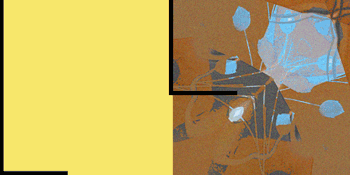
Now let’s go back to 2022. If you see a demonstration somewhere in the city where son jarocho is present ,you might hear jarana there playing probably “La Bamba.” The feminism in Mexico City is very strong, and I know the group of jaraneras who go to the demonstrations. As jaraneras, they prepare the verses and the music. And when I say prepare, they write new verses for their struggle, their demands. [strums “La Bamba” in the background while continuing to speak]. “La Bamba’ is from the 1700s when Veracruz was being attacked by pirates. Veracruz is a city and port in the Gulf of Mexico. At that time it was the most important city. But nowadays you can sing something like, “Hey / I don’t like these elections / I don’t like these elections / because they don’t represent my —” Then you can finish it. I’ll leave you with a little homework [laughs]. So that’s how “La Bamba” became relevant to 2022.
The rhythm, that’s what the verse is saying, the same pulse, the same beat. We’re using it. And when I say the whole world, you know, it’s just a way to make it sound majestic. But the whole jaranero/a world, whoever carries a jarana, becomes part of my family somehow. If I see someone carrying a jarana in England I’ll be like, wait, where do you get that one? I probably know who made it and that’s it, we start talking, connecting. So that’s the world that I’m pretty much talking about, the people that they touch with their music. Luchamos, we fight back, we struggle every time. That’s where I belong, in the part of the society that doesn’t feel well-represented. I’m talking about Mexico and the US. I’m a citizen of two countries, which makes it harder.
For a while we’ve been pushed toward individualism, and when you have fandango, it’s [about] gathering, and no matter what level of musicianship you have you can participate, that gives you a feeling of confidence.
Jessica: You also mentioned earlier that you’re actively teaching and sharing the music in many spaces, and with lots of different audiences, and I’m wondering if, to close out, you could share any stories about responses you’ve gotten or changes you’ve noticed from people who become interested in playing or listening to the music.
César: Wow! I’ve heard some people after they were in my classes or after they realize that son jarocho and fandango is something that now is an essential part of their life. First of all, they’re very thankful for the way they were introduced to it. Also, they find a way to express, a way to communicate, a way to feel connected to other people. For a while we’ve been pushed toward individualism, and when you have fandango, it’s [about] gathering, and no matter what level of musicianship you have you can participate, that gives you a feeling of confidence. You start believing in yourself when you develop a musical ability that you didn’t think you had. And then if you jump onto the tarima and start dancing to this music, which is a [kind of] stomping, it’s very rhythmic. The energy that it requires feeds you back. You might get tired, you do get tired, but somehow you reload yourself. I’ve seen people change. I have seen so many beautiful things.
I also teach in California State prisons. One of my ex-students from there was released. Sorry, I used that word, but it’s a horrible word. I probably used it because that’s what they use. Instead, I’m gonna say he finished his rehabilitation process, because that’s what I do there. I go there to teach son jarocho and to share what it’s all about, but I always make sure that they find a way to translate it to their own culture. I don’t want them to feel obligated to be part of the son jarocho community. These fundamentals can be used wherever you go in the world.
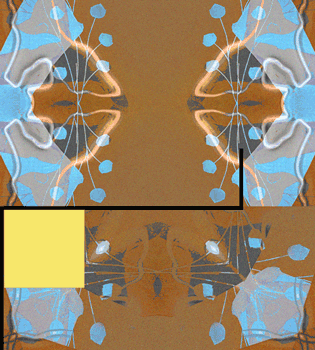
Anyway, this student found me on Facebook and sent me a message like, “Oh, this is X. Remember me?” I said, “Yes, of course I remember you. How are you doing?” And it happens that he was in college, and he was looking for me because he wanted to write a paper about something positive that happened in his life. And he said that during the period of being there, my class was something that gave him hope, and that gave him so much joy, even freedom. That, to me, is invaluable to hear. I felt very proud of this work, and I always make sure that that feeling goes to whoever made it possible for me to get this music and these instruments in my hands. I always thank my teachers and my ancestors. If they’re alive, I’ll give them a call or send them a message through email. Old school. Or if they are not, then I just send a message out there.
Jessica: That’s lovely. I want to thank you so much for sharing everything. There are many things to take away from it but I think more than anything I love the clear sense of community that is so attached to the instrument, and also just clearly how much you love it. From the material, through the process of making it, to the actual playing, and then sharing it with others. At every step of the way it’s really special. So thank you for that.
César: Oh, my pleasure! Well, thank you for this interview, because every time I get an interview it’s a good chance for me to update and to reach other people and tell them, look, son jarocho is my thing, but probably some of what you heard today might help you get into what’s around you. That’s what defines culture, and makes it better. We’re responsible, all together, not just one person. Never.
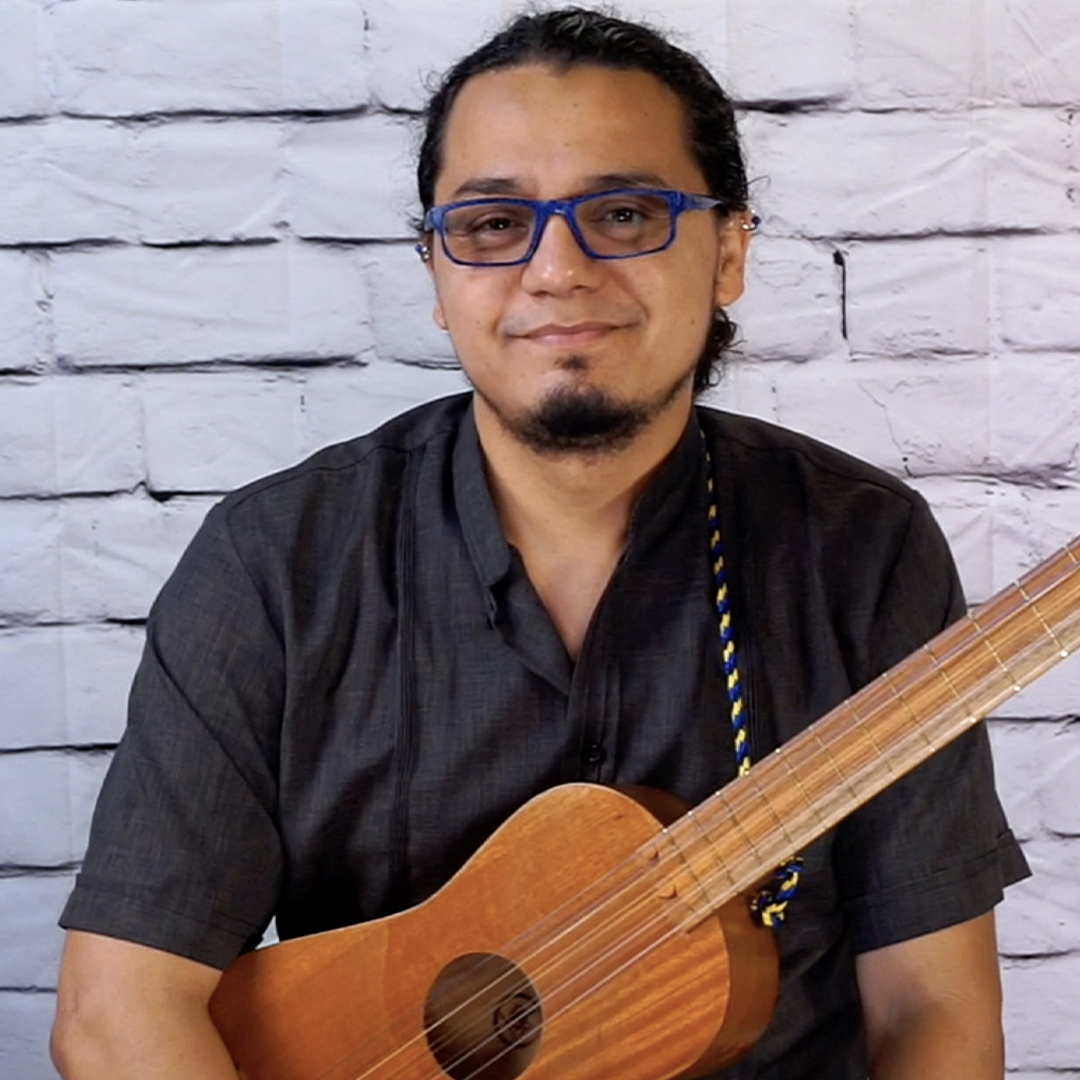
[ID: A seated man with his jarana in front of a white brick wall. His dark hair appears pulled back and he looks out from behind blue framed glasses with a relaxed pose and a small smile.]
César Castro
He // Him // His
Los Angeles, CA
César Castro’s career emphasis is on community building, organizing, and engagement through projects in participatory art forms, specifically, traditional music from Veracruz, Mexico. Castro’s vast knowledge and experience is in using music and other traditional art forms to engage disenfranchised communities in building self-sustaining projects that tap into and build upon constituent cultural knowledge, experience, and memory. Additionally, he is a professional musician in the son jarocho genre, a laudero (stringed instrument maker), and an instructor. He has been an active liaison between communities in the US and Mexico for over fifteen years via Radio Jarochelo, a community-based podcast which began in 2010. Castro has had the most impact organizing and promoting cultural projects and events in local communities, cultural centers, schools, universities and, most recently, in California state prisons.
